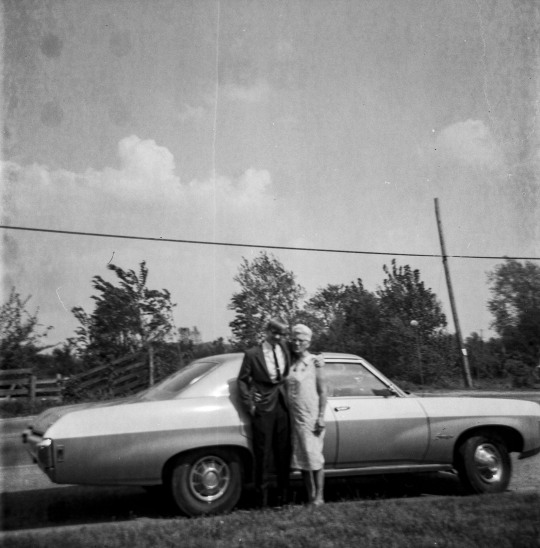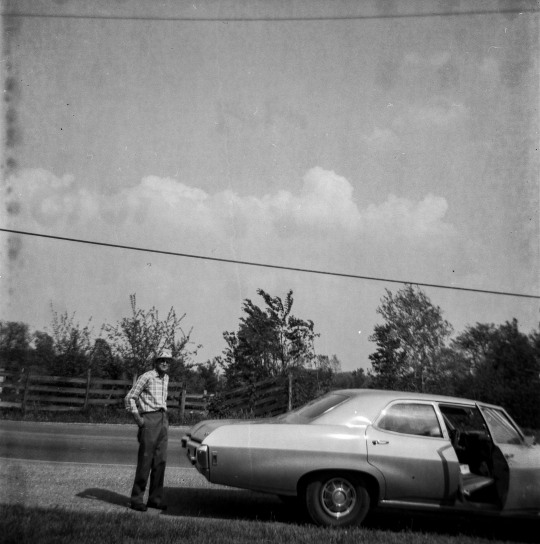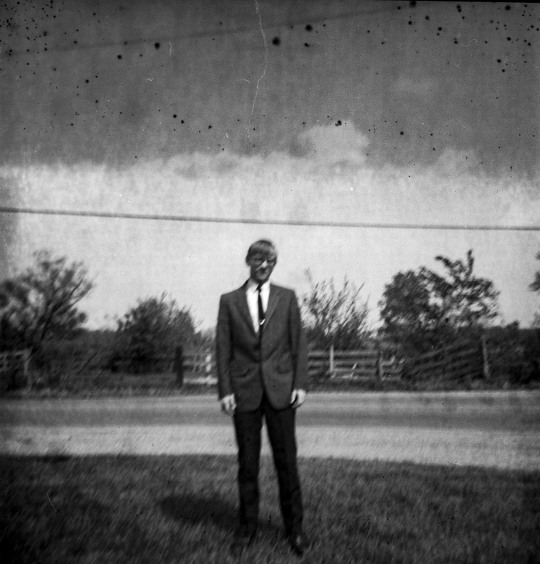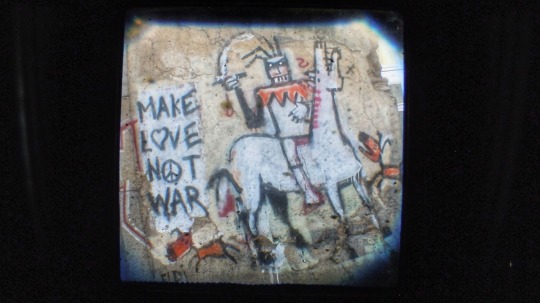#Pseudo TLR Camera
Explore tagged Tumblr posts
Text
Zeh Zeca-Flex Camera
This camera combines the compactness of a folding camera with the quality and handling of a twin-lens reflex camera. The Zeh Zeca-Flex is just the camera mentioned above, and I've had my eye on it for many years. However, the rareness and price have always eluded me until I went into a great used camera store in Salt Lake City, UT, Acme Camera.
The first time I went into Acme Camera, they were in their older location, and the store was filled with photo knickknacks. I struck up a conversation with the people there who were selling used gear, servicing cameras, and renting for the local photo community. On my second visit, back in one of the cases was the Zeca-Flex I currently have. The camera was in excellent condition, with clean optics and a working shutter. I offered a trade for the camera, and they accepted. I was elated to have the camera so I could do a blog article on my Zeca-Flex.
History:
In the early 1900s, around 1901-1902, Paul Zeh produced camera parts like shutters in his workshop in Dresden for some of the other local camera companies in Germany. In 1913, he started producing cameras, and by 1922, the company Paul Zeh Kamerawerk was started. In the early years, the company mainly produced folding plate cameras or cameras that took images on glass plates, which was very common at that time period.
During the 1920s, the company did very well. At this time in photo history, roll film was starting to become more popular. The photographer or photo enthusiast didn't need to carry bulky film holders. All the photographer needed to do was put in a roll of film and get 8, 10, 12, or 16 different photos on the same roll of film without the hassle or inconvenience of loading and carrying the film holders.
The Pilot Reflex camera, produced in 1931 by Kamera-Werkstätten Guthe & Thorsch in Dresden, has a very similar style and appearance to the Perfekta and the Super Perfekta; you can see a review by Mike Eckman of the Pilot.
During the late 1920s and 1930s, the company expanded production into folding roll film cameras. These cameras were more compact and allowed the photographer to travel with less equipment, so their popularity grew.
By 1937, Zeh produced the Zeca-Flex, a folding, twin-lens reflex camera. Its design is very similar to that of the Welta Perfekta, which was produced in the 1933-34 timeframe, and the more robust Super Perfekta introduced in 1935. The Perfekta and Super Perfekta were made by Welta Kamera Werk, which was in Freital, a very close town to Dresden.
I'm confident Zeh wanted to compete with Welta on this camera style. Unfortunately, this camera style didn't catch on with consumers. Hence, with all three cameras, the Perfekta, Super Perfekta, and Zeca-Flex were the only cameras made and are rare and somewhat expensive.
WWII took a toll on Dresden as the Allies leveled the city due to its large manufacturing capabilities. By 1948, the Zeh plant closed, and the company went out of business. My guess is that some of the Russian companies took some of the camera manufacturing machines to produce some of the after-war cameras. This is just my guess, though.
My Camera:
The condition of my Zeca-Flex is unusually excellent for a camera that is almost 90 years old. The metal is still shiny, and all the functions move like when the camera was first purchased in the late 1930s.
The camera measures 7.5" long without the light hood open. When the light hood is open, it measures 9.25" tall. The Zeca-Flex is 3.75" wide and closed; it's 2.5" from the front of the viewing lens to the rear of the camera. When the camera is open, it measures 4.75". The Zeca-Flex weighs 2lb—5.2 oz.
The lens on my Zeca-Flex is a Schneider Xenar 7.5cm (75mm) f 3.5 in an F. Deckel Compur Rapid shutter. The shutter speeds go from 1/400 to 1 sec with both "T" and "B" settings. Since I don't have a proper shutter tester, all the shutter speeds sound accurate to my trained ear. The viewing lens is a Sucher Anistigmat f2.9 lens.
To open the camera, there is a small button on the left side as you hold it to take a photo. Press that small button in, and the lens door unlocks. On my camera, you need to pull out the lens to put it into the taking position. There are knurled grips on the sides of the lens door to pull the lens out. Also on the lens door is a flip-out stand that allows you to stand the camera up, which is very common in folding cameras.
To close the lens, there are two buttons on either side of the backdoor. You press in towards the camera body, then slide the lens back into it and close it until you hear the locking "click" sound, which means the lens is back and locked in the camera body.
On the back of the light hood, there is a sliding bar you slide over to open the light hood for viewing purposes, and on the side of the light hood is a switch you can flip up or down the magnifying glass for critical focusing.
There is a latch at the top of the back door, which you slide up to open the film door to load and unload film. In my camera, there is a roll film holder you put the roll of film into before putting it into the camera. The film holder is something I've never seen before, and on the first roll, I needed to figure out which way the film rolled across the shutter, but it was easy to figure out. Now that I've done it, it makes sense, and I won't have difficulty in the future.
The frame counter resets to number 1 when I close the back of my camera, or at least it was there when I put film in it. There is a button on top of the frame counter. When I slide that button over, the frame counter goes to number 5, so my guess is that isn't correct. I can't find an instruction manual for this camera online, so I'm not 100% sure of the correct way to get maximum frames from the camera.
There is a red window on the back, which I'll use in the future, as I did miss a few frames at the beginning of the roll when I shot with it. The film advance is on the bottom of the camera and is directly tied into the frame counter, whether you have film in it or not. The frame spacing on my camera was good once I got to the first frame and used the frame counter to find the next frame.
To focus the lens, as you hold the camera to take photos, there is a wheel next to the viewing lens. I rolled my finger across it one way or the other to achieve proper focus, which was the easiest and made the most sense to me.
Results:
Now that I had a roll of film in the camera, I took it out and walked around the neighborhood to get some photos. Here are some pictures I took on my walk with the stunning Zeca-Flex camera.
Conclusion:
The viewfinder wasn't the brightest, and achieving good focus was difficult even with the magnifying glass up. Another negative about using the camera is where the shutter release is placed. There is no shutter release button, so you need to cock the shutter and then release it with the shutter release button, which is in an awkward place and thought my finger would be in the photo, but it wasn't.
Besides these two items, the camera was a joy to shoot with, and I feel lucky that my camera is in such good condition. I will use it again, but I'm putting it back on the shelf and trying something different for next week's blog post.
Thank you for taking a few minutes to review some of the cameras in my collection.
Please be safe, and I hope to hear from you soon.
#Zecaflex#Zeca-Flex#Zeca-flex camera#german camera#cameras from Germany#TLR#Pseudo TLR Camera#folding camera#zeca#zeh camera#precision cameras#dresden#germany#schneider#schneider lens#schneider optics#120 camera#120 film#120 film camera#Medium format#6x6 format#acme camera
0 notes
Text
Through the Viewfinder Photography with the Kodak Duaflex Pseudo-TLR Camera
When I started experimenting with Through the Viewfinder (TTV) photography, many of the articles I found about the technique referred to the Kodak Duaflex pseudo-TLR camera as the ideal choice for TTV because of its brilliant viewfinder. At the time I couldn’t find a Duaflex at a reasonable price and settled for the Ferrania Elioflex pseudo TLR camera coupled with a Nikon Coolpix S8000 digital…

View On WordPress
2 notes
·
View notes
Text
Ensign Ful-Vue II: The Restoration
So last month I got this quirky little 1950’s British made camera in a charity shop. An Ensign Ful-Vue II. A medium format camera which was a pseudo-TLR which worked more like a box camera as it had both a fixed aperture (f11) and a fixed shutter speed (1/30th).

It had seen better days as it had dirt and paint chips all over, the shutter release lever occasionally stuck after actuating the mechanism, the strap had pretty much had it and the lock/unlock knob for opening it had lost its cap. But surprisingly for its age the optical elements were only a touch dusty, and after a quick wipe were extremely clear and bright. Considering the condition of the glass and the fact it took 120 film (very much still readily available) I decided to try and get this camera looking as good as possible.
First step was to strip it down and mask up any areas I didn’t want paint getting to. This camera is really quite basic in design, so I had the whole thing stripped down with 3 screws and 1 clip removed.

When masking up the film caddy part, I took extra care to make sure this original advertisement sticker didn’t get damaged.

I decided that to get the best finish, removal of the old paint would probably be best. I initially tried removing it using wire brush tools that came with my rotary tool, and although it was removing the paint it was burning through the brushes too fast. 5 brushes dead and all that was done was 60% of one side. An upgrade was needed.

I started treating the surface with isopropyl alcohol then attacking it with a much bigger brush that could handle higher RPMs without losing its bristles. What took 20 mins with the rotary tool was 5 mins with the drill/brush combo. Progress!

I briefly reassembled the camera at this stage to see how it looked. I was tempted to polish up the metal really well at this point and either have it unpainted or some sort of two-tone effect, but decided to try and keep it original as possible as per the initial plan. I disassembled it again and cracked open the can of matte black spray paint.

Whilst waiting for the spray paint to dry, I dealt with that sticking shutter release lever. I oiled the mechanism using a cotton bud and some oil. I didn’t want to put too much on in case it flicked onto the glass elements during use. That said, unlike other cameras I owned I could at least strip this down easily and clean it off if it did.
With the mechanism working more smoothly than it has done in decades, all that was left was to clean the glass elements.

The moment of truth. The removal of masking tape and reassembly. And I must say I’m very happy with the results. The finish on one side isn’t perfect and it seems I’d scratched the paint ever so slightly when moving the pieces after spraying, but even with these minor points it looks so so much better.



All that’s left to do now is source a new strap and to see if I can fabricate a new cap for the lock/unlock knob.
#vintage cameras#vintage#restoration#120 film#medium format#fulvue2#film photography#analog photography#old camera#repair
4 notes
·
View notes
Photo

Vintage 1950's Kodak Duaflex 3 Flash Outfit Camera
Vintage 1950"s Kodak Duaflex 3 Flash Outfit Camera. This camera comes in original factory box but factory box is in poor condition. This camera overall in very good condition but will still look used. The camera comes with a 33 page Black & White picture manual. The camera will come with 1 white flash bulb. Of course this item is for collection only unless you can still film for it because the film would have the battery built in to the film so camera would operate. There are no cracks in camera or lenses and all the lenses you can still see threw them just fine. Produced 1950-54 (Dec. 1952) Eastman Kodak Co., Rochester, NY USA Film type 620 roll film Picture size 6×6 Weight 1lb, 1.4oz (493.3g) Lens Kodak 72mm 1:8 Focal range 3.5′ to infinity Shutter simple spring w/sliding aperture disc (f8, f11, f16) Shutter speeds Instant, about 1/30 plus ‘B’ Viewfinder mirror reflector Exposure meter none Double-exposure lock The Kodak Duaflex is a 620 roll film pseudo TLR made by Kodak in the US, Canada, and UK. The original versions were available from December 1947 - September 1950 in the US, and 1949-1955 in the UK; the Duaflex IV was finally discontinued in the US in March 1960.[1] The various Duaflex camera's had Bakelite bodies (identified by Kodak as "Kodadur") with metal fittings and trim, and were available with either a simple fixed focus 75mm f/15 Kodet lens, or with a 72mm f/8 Kodar triplet lens in a front-element focusing (to 3.5 ft.) mount. The Kodar lens had Water house stops of f/8, 11, and 16. The shutter had speeds of "I" and "B", and was synced for use with a Kodalite Flasholder. Early U.S.-made models (Duaflex and Duaflex II) had a dedicated Duaflex Flasholder, which was synchronized for SM and SF bulbs when the camera was set on "I". No. 5 and No. 25 bulbs could be used, but the "B" setting was required for those types. Later models (Duaflex III and IV) were modified to accept the aforementioned Kodalite Flasholder, which was also used on the Brownie Hawkeye Flash Model and other Kodak models. A special feature of the Duaflex line was double-exposure prevention, meaning the advance knob had to be turned to the next exposure before the shutter could be activated. This feature could be overridden by pushing the little lever below the shutter button.Box or package may not be in the best condition. Have Question Just Ask?
Listing and template services provided by inkFrog


0 notes
Text



Acomiadant el fill / Saying good-bye to the son; Amb el gran cotxe / With his large car; Un Oscar Dalmau a Ohio? by SBA73
Via Flickr:
Ningú havia vist aquestes fotos fins ara, sobretot els que les varen fer. Fins que jo les he revelat ara. S'anomena "found film" a aquelles fotografies en pel•licula o placa que es troben sense revelar dins càmeres velles o per altres racons. La gracia és que ningú ha vist mai aquestes fotografies. Per l'escena, sembla un matrimoni acomiadant al fill que s'envà... potser a la universitat, a una feina llunyana... qui sap. Algú sap identificar el model de cotxe? Aquest rodet de format 620 prové d'un conjunt comprat a algú de Botkins, Ohio, Estats Units. Es tracta d'un rodet sense marca però amb el text Panchromatic Film i Made in Belgium. Això em fa pensar que es tracta de emulsió Gevaert o Agfa-Gevaert. Pel tipus d'escena i el cotxe, es deu tractar dels Estats Units (Ohio?) cap als anys 70. Al paper exterior algú va anotar que la càmera emprada fou una Kodak Duaflex II, una pseudo-TLR amateur. Aquest rodet el vaig revelar amb HC110 durant 5 minuts a 20º. =================================================== Nobody, even less the author, had seen these pictures until now. Until I've developed them in the dark room. They call "found film" at those images in film or plates that are find undeveloped inside old cameras or in other places, like boxes or old houses. The scene seems to show an older couple saying good-bye to their son who is going to... the college? some distant workplace? Who knows... Any idea of the model of the car? This 620 roll was part of a pack I bought from a seller in Botkins, Ohio. It was only marked as "Panchromatic Film" and "Made in Belgium", wich makes me think it was a Gevaert or Agfa-Gevaert emulsion. These pictures were probably taken in the US (Ohio?) in the 70's. In the outside paper somebody had noted that the camera used was a Kodak Duaflex II, an amateur pseudo-TLR. This roll was developed in HC110 at 20ºC for 5 minutes.
0 notes
Video
Vintage Argus Seventy-Five Pseudo TLR Film Camera, Uses 620 Film, 75mm Lumar Lens, Made In USA, Introduced In 1949 (No Date Code On This Camera) by Joe Haupt
#Vintage Argus Seventy-Five Film Camera#Vintage Camera Collection#Vintage Film Cameras#Vintage 620 Film Camera#Old Film Cameras
1 note
·
View note
Text
Photavit Photina Reflex
The Photina range seems to have been modelled on the Voigtländer Brillant range. The first two Photina cameras were pseudo-TLRs – they look like a proper TLR camera but the upper lens is a static viewfinder (essentially a very large Brilliant finder). This Photina – the Reflex – is like the last Voigtländer Brillants in as much as it is a true focusing TLR.

This is a cheap camera and…
View On WordPress
0 notes
Photo

Fairly rare... or at least the first in my collection. The U.S. Camera Corp. Reflex III. The Reflex III is a pseudo TLR made by the United States Camera company (17 North Loomis Street, Chicago, Illinois, U.S.A). It is primarily made of plastic and features a fixed aperture and shutter speed with a plastic positive meniscus lens. Uses 620 film. #explorewithfilm #analog #lomo #USC #analogphotography #vintagecamera #photo #instantfilm #lubitel #landcamera #vintage #photography #camera #collection #film #filmcameras #filmcamerasinternational #filmshooters #filmlovers #filmisnotdead #letsshoot #filmisalive #retro #onedayonfilm #watchthisinstagood #l0m0graphy #dowhatyoulove #rollei
#onedayonfilm#analog#photo#explorewithfilm#camera#dowhatyoulove#landcamera#filmshooters#watchthisinstagood#film#lomo#filmcameras#rollei#vintagecamera#l0m0graphy#instantfilm#filmlovers#retro#usc#collection#letsshoot#filmcamerasinternational#photography#filmisalive#lubitel#filmisnotdead#analogphotography#vintage
0 notes
Photo

1954 Anscoflex 📸 . an unusual enamelled-metal pseudo TLR with a large lens cover which slides up to form the viewfinder hood. It was built in the USA & design by Raymond Loewy. The aperture (f/11) and shutter speed are fixed. It takes 6x6cm images on 620 film, wound by a large, ratcheted knob in the side. It retailed for approximately $27.95 (1956 Sears catalog) The camera was advertised as an inexpensive easy to use quality camera. ▫️Manufactured between: ▫️1953-1956 ▫️Twin Lens Reflex ▫️Focal Distance: 6 Feet - Infinity ▫️Shutter Type: Rotary ▫️Shutter Speed: 1/60th# Image: @vintagecameralab
0 notes
Text
A test run with the Kodak Duaflex TTV Contraption
After completing the Kodak Duaflex pseudo TLR camera and Nikon Coolpix 5900 digicam combination it was time to take the Contraption for a walk in the woods and fields behind our house. Of course the first series of images I took with the Contraption was of my favourite tree and well just across the road. I also tried to make trichromes and digital aerochromes with the Nikon digicam set to black…

View On WordPress
0 notes
Text
First frames with the Voigtländer Brillant pseudo TLR camera, 31 March 2024
A couple of weeks ago I posted about the Voigtländer Brillant pseudo TLR camera. I had picked up this one from the Kamerastore website for 15€ under their ‘not passed’ category because the slow shutter speed of 1/25s was faulty and the viewfinder doors would not stay closed. From the Brillant’s serial number (E192998) I dated it as being from 1933, ninety-one years old. After a general clean of…

View On WordPress
1 note
·
View note
Text
A Sudden Attack of GAS:The Voigtländer Brillant pseudo TLR camera, 03 March 2024
I feel that I’m reaching GAS saturation point. I have most of the film cameras on my wish list now, and although I’m always on the lookout for some interesting noughties digicams I’m nearly there with digital cameras too. But sometimes … sometimes I come across a camera that calls out to me and I think, ‘I have to get that’. And so it was that I was on the Kamerastore website recently and came…

View On WordPress
0 notes
Text
Jankuary: Through the viewfinder photography (TTV) with the Ferrania Elioflex pseudo TLR camera, 24 January 2024
After a couple of false starts, and one experiment that is coming along nicely but still needs some work, Jankuary is getting into full swing. Devised by Azriel Knight, Jankuary is ���a month-long theme of weird cameras, strange hybrids of old tec and new, and general strangeness in photography’, and my experiments with Through the Viewfinder (TTV) photography certainly fits the bill. I first…

View On WordPress
#Contraption#digitalcamera#Ferriana#Jankuary#ThroughTheViewfinder#TTV#TwinLensReflex#WaistLevelFinder
1 note
·
View note
